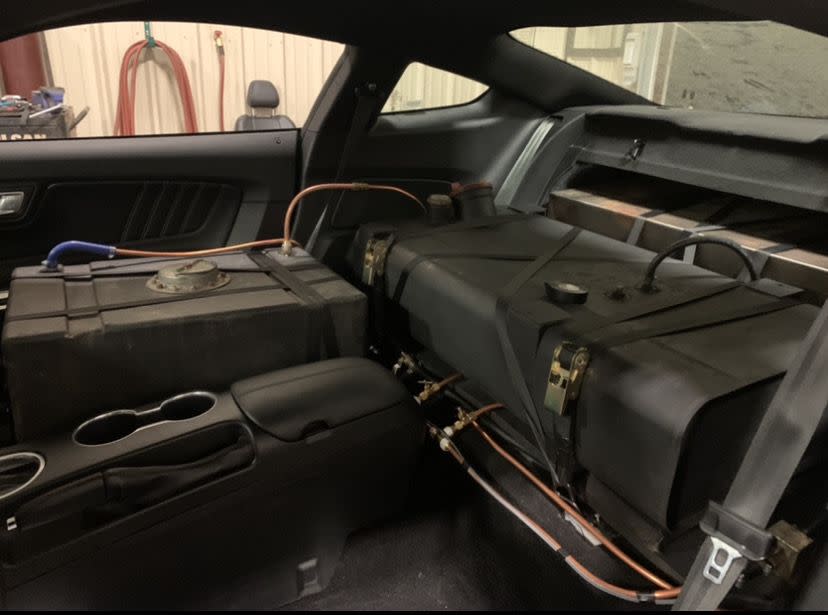A Man Drove Solo Across America in 25 Hours 55 Minutes in a Rental Mustang

You'll be forgiven for stifling a yawn as we delve into the details of yet another Cannonball record. And although the overall New York City-to-Redondo Beach, California record has allegedly been broken again by some folks who have not yet emerged from the shadowy world of hearsay and conjecture, that's not the one we're going to tell you about today. What we're here to talk about is a record that's so stupid it's brilliant, and so crazy it's just about what we've come to expect as the elapsed times on these ill-advised adventures have crept ever closer to the 24-hour mark.
We're talking about a solo run. One man, one car, a whole lot of gasoline, and an alleged 25-hour, 55-minute elapsed time. That’s an average speed of nearly 108 miles per hour.

If you've been following our coverage, you'll know that a lot of people got excited last November when Arne Toman, Doug Tabbutt, and Berkeley Chadwick destroyed a coast-to-coast time that had stood since 2013, behind the wheel of a superbly prepared, blisteringly fast 2015 Mercedes-Benz E63 AMG sedan that carried them across this nation in 27 hours and 25 minutes. You'll also know that, since then, we've offered limited coverage of the rash of coast-to-coast record attempts made since then.
And you'll recall some measure of derision aimed at the trio (or quartet, who knows) of shteebs who borrowed someone's daddy's Audi, ratchet-strapped a couple of marine fuel tanks into the trunk, and blasted to glory while most of the country was closed as a global pandemic exacted its grim toll.
But while most of us were twiddling our thumbs at home during the COVID-19 closures (or mourning the loss of our jobs, or dying), a handful of scofflaw endurance drivers were busy making tracks from New York to L.A. Several of these were solo runs, and those of us in the know watched, amazed, as the time it took one person to drive 2800 miles nonstop plummeted from the low-to-mid-30s to just under 28 hours. Even those times, set only a few months ago, were blown out of the water recently when Fred Ashmore, 44, of Hancock, Maine, rented a Mustang GT, removed its passenger seats and other interior accessories, strapped in enough extra fuel tanks to bump the car's capacity to around 130 gallons, and made the trip from the Red Ball garage in Manhattan to the Portofino Hotel & Marina in Redondo Beach with only one stop for fuel.
"The Mustang GT will not go any faster than 159 miles per hour," he told Road & Track. "Anyone who tells you otherwise is lying."
It is important to note that Ashmore's time, while impressive, is not accompanied by the trove of third-party-verified GPS data that has become the "standard" measure of proof in this non-sanctioned non-event. Hence the "allegedly" qualifier. But he did take a shitload of screenshots of his Glympse tracking app while he was driving (he sent updates to his brother, his girlfriend, and his refueling team), and the images do not appear to have been doctored. Consensus among those who know him is that Ashmore, while batshit crazy, is not a liar.
"When you look at a solo pursuit, that's not really a challenge many people have taken on," said Ed Bolian, whose 28-hour, 50-minute record stood until November 2019. "That's so off-the-wall and superhuman, I find it a lot more entertaining to watch as a spectator."
On a team run, the driver drives, and the passenger or passengers monitor the police-detection devices, man the gyro-stabilized binoculars, make calculations and corrections, and communicate with people on the ground.
"When you're on a team, if you’re the spotter, you can take a break and close your eyes for a few minutes," said David Simpson, a truck driver and author who set a 34-hour, 33-minute solo record in 2015. "On a solo run you don’t have a chance to unwind, even when you make a gas stop, because you’re just so busy the whole time."
Bolian, who has always preached the merits of painstaking preparation, noted that the ad hoc nature of Ashmore's run was likely key to his success.

"In general, the risks inherent in making a Cannonball record attempt have been managed by meticulous planning and strategy," he said. "We have always known that throwing caution to the wind and just going as fast as possible could be another route to success. Until now, no one has been crazy enough to accept the risk, and Fred went full send."
Ashmore was lucky, and avoided the worst-case scenario today’s high speed drivers seem to be inching toward inexorably. Bolian is happy the Cannonball safety record remains—for now—unblemished.
Considering the amount of money previous record holders have spent on the aforementioned meticulous prep, Ashmore’s effort shines as an example of extreme frugality. He says he didn't spend more than $3000 on his whole trip, including the car, its strapped-in, Facebook Marketplace-sourced fuel tanks (and fuel), and the electronic countermeasures that have become de rigueur for anyone wanting to drive at these speeds without landing in jail. It was a drop in the bucket next to the budget for Toman's professionally-prepared AMG, or even the tens of thousands Bolian says he spent on his car and countermeasures leading up to his 2013 record run. Alex Roy, whose cutting-edge electronics predated the democratization of cop-spotting social media apps when he set the first of the modern records in 2006, is in another league altogether, budget-wise. (There’s a movie about that.)


 Yahoo Autos
Yahoo Autos 